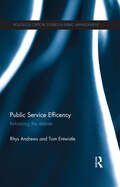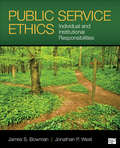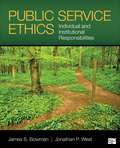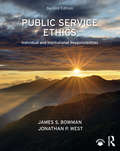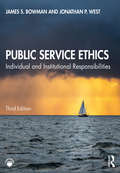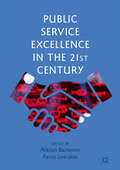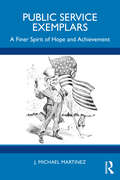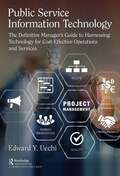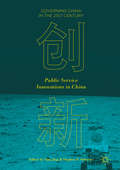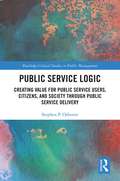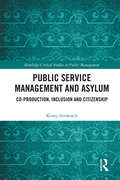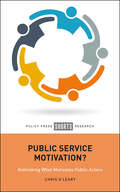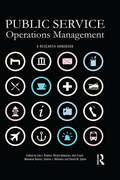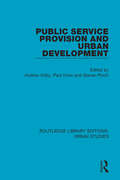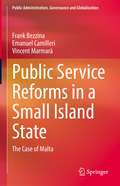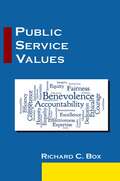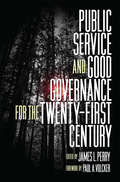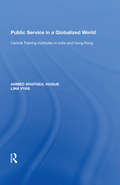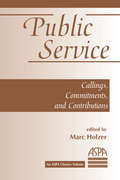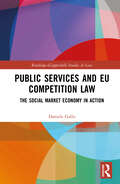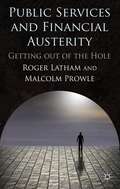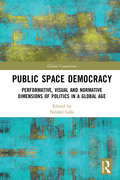- Table View
- List View
Public Service Efficiency: Reframing the Debate (Routledge Critical Studies in Public Management)
by Rhys Andrews Tom EntwistleThe current economic and political climate places ever greater pressure on public organizations to deliver services in a cost-efficient way. Focused on the costs of service delivery, governments across the world have introduced a series of business like practices – from performance management to public-private partnership – in the belief that these will increase the efficiency of their public services. However, both the debate about public service efficiency and the policies and practices introduced to advance it, have developed without a coherent account of what efficiency means in this context and how it should be realized. The predominance of a rather narrow definition of the term – very often focused on the ratio of inputs to outputs – has tended to polarise opinion either for or against efficiency agenda. Yet public service efficiency, more broadly conceived, is an inescapable fact of the public manager’s task environment; indeed in the past, the notion of efficiency was central to the emergence of the field of public administration. This book will recover public service efficiency from the relatively narrow terms of recent debates by examining theories and evidence relating to technical, allocative, distributive and dynamic efficiencies. In exploring the relationship between efficiency and democracy, this book will move current debates in public administration forward by reflecting on the trade-offs between the different dimensions of efficiency that public organizations confront.
Public Service Ethics: Individual and Institutional Responsibilities
by Dr James S. Bowman Dr Jonathan P. WestEthics—in all its exemplary and exhausting forms—matters. It deals with the most gripping question in public life: “What is the right thing to do?” In Public Service Ethics: Individual and Institutional Responsibilities, James Bowman and Jonathan West examine individual-centered and organization-focused ethics, applying ideas and ideals from both to contemporary dilemmas. The authors take on controversial issues—from whistle blowing incidents to corruption exposés—to explain how they arise and suggest what can be done about them. They start with the conceptual tools students need to evaluate an ethical dilemma, then analyze individual decision making strategies, and go on to assess institutional ethics programs. The emphasis is not only on the “how to,” but also on the “why.” The ultimate goal is to bolster students’ confidence and prepare them for the ethical problems they will face in the future, by equipping them with the conceptual frameworks and context to approach thorny questions and behave ethically.
Public Service Ethics: Individual and Institutional Responsibilities
by James S. Bowman Jonathan P. WestThe emphasis of this text is not only on "how to," but also "why", and the book offers readers practical knowledge and insight into ethics in government. To that end, the book is not about right and wrong answers. Rather it aims to understand ethics and human behaviour in an analytical, yet provocative manner by extending one's ordinary moral experience by making it explicit, clearer, and more consistent.
Public Service Ethics: Individual and Institutional Responsibilities
by James S. Bowman Jonathan P. WestEthics—in all its exemplary and exhausting forms—matters. It deals with the most gripping question in public life: "What is the right thing to do?" Now in a thoroughly revised second edition, Public Service Ethics: Individual and Institutional Responsibilities introduces readers to this personally relevant and professionally challenging field of study. No matter the topic—the necessity of ethics, intriguing human behavior experiments, the role of ethics codes, whistleblowing incidents, corruption exposés, and the grandeur and decay of morality—there is no shortage of controversy. The book enables readers to: appreciate why ethics is essential to leadership; understand and apply moral development theory at the individual and organizational levels of analysis; differentiate between ethical problems and ethical dilemmas, and design creative ways to deal with them; develop abilities to use moral imagination and ethical reasoning—to appraise, argue, and defend an ethical position, and cultivate individual and institutional initiatives to improve ethical climate and infrastructure. Authors James Bowman and Jonathan West capture reader interest by featuring learning objectives, skill-building material, discussion questions, and exercises in each chapter.? The authors’ narrative is user-friendly and accessible, highlighting dilemmas and challenging readers to "own" the book by annotating the pages with one’s own ideas and insights, then interacting with others in a live or virtual classroom to stretch one’s thinking about the management of ethics and ethics of management. The ultimate goal is to bolster students’ confidence and prepare them for the ethical problems they will face in the future, equipping them with the conceptual frameworks and context to approach thorny questions and behave ethically.
Public Service Ethics: Individual and Institutional Responsibilities
by James S. Bowman Jonathan P. WestThe study and practice of ethics, in all its exemplary and execrable forms, matter now more than ever. It deals with one of the most gripping questions in life: "What is the right thing to do?" Public Service Ethics: Individual and Institutional Responsibilities, Third Edition, introduces readers to this personally relevant and professionally challenging field of study. No matter the topic—the necessity of ethics, intriguing human behavior experiments, provocative approaches to decision-making, new theories to understand ethical actions, the role of ethics codes, whistleblowing incidents, corruption exposés, and the grandeur as well as decay of morality—there is no shortage of controversy. This book discusses these issues, explains how they arise, and suggests what can be done about them. The authors make the narrative user-friendly and accessible by highlighting dilemmas, challenging readers to resolve them, and enticing them to go beyond the text to discover and confront new issues. New to this Third Edition: Exploration of fascinating and important new topics such as the Green New Deal, Black Lives Matter, oaths of office, classroom dishonesty, state corruption, the Biden administration, and the ethical challenges of the COVID-19 pandemic and response. In-depth profiles of newsworthy figures, including Michael Flynn, Alexander Vindman, Anthony Fauci, and John Lewis. All new case studies drawing on actual and hypothetical events to give students an opportunity to apply concepts and analytical frameworks. All new end-of-chapter discussion questions and exercises to encourage students to think more deeply about ethical issues. The authors' conversational writing style invites readers to annotate pages with their own ideas, experiences, comparisons, and insights, bolstering students' confidence and ultimately preparing them for the ethical problems they will face in their own careers. This lively and thorough new edition is required reading for all public administration and public policy students.
Public Service Excellence in the 21st Century
by Alikhan Baimenov Panos LiverakosThis book combines academic wisdom and practitioners’ insights to critically examine the challenges faced by civil service systems in the 21st Century. Moreover, the book evaluates what types of civil servants are needed to tackle critical issues such as rapidly ageing populations, increased urbanisation, environmental degradation, swift technological advancement, and globalisation of the market place in the social and economic realm of the 21st Century. Its topics range from civil service development in post-Soviet countries indicating that peer-to-peer learning is the way forward, to civil service reforms in China, Japan, and Korea in their quest to satisfy their citizens demands and expectations in the 21st Century. Other topics span across regional analyses by focusing on current dominant trends and challenges confronting administrative and civil service systems, vis-à-vis technology, innovation and “big data”, and their disruptive effects on society and government. This book will be of interest to both academics and practitioners, and would-be builders of the 21st Century world.
Public Service Exemplars: A Finer Spirit of Hope and Achievement
by J. Michael MartinezUnderstanding and encouraging the development of good leaders are so important that schools of business administration, public administration, public policy, and organizational development teach courses in leadership. Within the public administration literature, scholars have discussed the value of studying outstanding individuals who have been uniquely effective in fulfilling their formal duties, as well as ethical in leading their organizations. Public Service Exemplars is the first book to highlight the decision-making styles of American public servants who serve as models of excellence in public service.While the roles they held, eras in which they served, formal training for the job, personalities, and relative levels of fame differ widely, the figures profiled in this book are united in their strong belief in the efficacy of government service and a willingness to employ innovative methods for accomplishing objectives. Examining three theories of decision-making by effective leaders (autocratic leadership, democratic leadership, and delegative leadership), this book explores the way that unelected leaders working within public agencies—and, in a couple of cases, the US military—reached decisions that are widely considered to be highly effective. Profiling leaders as diverse as Robert Moses, Frances Perkins, James Webb, Colin Powell, and Anthony Fauci, to name a few, Public Service Exemplars questions whether great leadership truly is, as it is often assumed, an elusive, almost indefinable quality. Can it be taught? Are effective leaders born, made, or a combination thereof? This book will be of keen interest to both current and future public service leaders, including students enrolled in public administration and nonprofit management courses.
Public Service Information Technology: The Definitive Manager's Guide to Harnessing Technology for Cost-Effective Operations and Services
by Edward UechiPublic Service Information Technology explains how all areas of IT management work together. Building a computer-based information system is like constructing a house; different disciplines are employed and need to be coordinated. In addition to the technical aspects like computer networking and systems administration, the functional, business, management, and strategic aspects all are equally important. IT is not as simple as expecting to use a software program in three months. Information Technology is a complex field that has multiple working parts that require proper management. This book demystifies how IT operates in an organization, giving the public manager the necessary details to manage Information Technology and to use all of its resources for proper effect. This book is for technical IT managers and non-technical (non-IT) managers and senior executive leaders. Not only will the Chief Information Officer, the IT Director, and the IT Manager find this book invaluable to running an effective IT unit, the Chief Financial Officer, the HR Director, and functional managers will understand their roles in conjunction with the technical team. Every manager at all levels of the organization has a small yet consequential role to play in developing and managing an IT system. With practical guidelines and worksheets provided in the book, both the functional team and the technical team will be able to engage collaboratively to produce a high-quality computer-based information system that everyone involved can be proud to use for many years and that can deliver an effective and timely public program to citizens. This book includes: Multiple layers of security controls your organization can develop and maintain, providing greater protection against cyber threats. Job-related worksheets you can use to strengthen your skills and achieve desired program results. Practices you can apply to maximize the value of your contracts and your relationships with for-profit companies and other contractors. New method for deciding when contracting or outsourcing is appropriate when internal resources are not available. Improved method for estimating intangible benefits (non-financial gains) attributable to a proposed project. An approach to deciding what parts of a business process should or should not be automated, paying critical attention to decision points and document reviews.
Public Service Innovations in China
by Stephen P. Osborne Yijia JingThis edited volume presents case studies of the transformation of China's public services over the past decade in China. As the country has experienced fundamental changes in its demographic, economic, social and environmental structures, demands on public services have been increasing tremendously, and have become unprecedentedly diverse. In response, innovations to provide new services, expand service recipients, adopt new technologies, engage partners, and streamline service processes have been employed widely in China to increase service efficiency, enhance quality, enlarge coverage, and improve citizen satisfaction. This book examines prominent cases of public service innovations in China, disclosing their causes, patterns, diffusion, and effects. These cases provide interesting evidence about the nature and effectiveness of public service innovations in China while highlighting to what extent these innovations can be explained by accepted theories and whether new theory building is needed. This book will be of value to academics and policymakers seeking to understand the evolving Chinese political system.
Public Service Logic: Creating Value for Public Service Users, Citizens, and Society Through Public Service Delivery (ISSN)
by Stephen OsborneThis book is based upon and extends the theoretical and empirical work of the author over the last decade. It integrates material deriving from his previous conceptual and empirical work in this field, together with new empirical evidence from emerging research. Public Service Logic challenges the product-dominant assumptions of the New Public Management (NPM) about the nature and management of public service delivery. Whilst the NPM has led to some important developments in public management, it has also had significant limitations and weaknesses. The book presents an alternative to this, as a framework for the future delivery and reform of public services globally. It draws upon the extant literature in the field of service management to argue for a Public Service Logic (PSL) for the delivery of public services. This situates public service delivery within the vibrant and influential field of service-dominant research and theory. It argues that effective public service management requires both that these services are understood as services not as products and that, consequently, public service management requires a focus on value creation as its over-arching rationale. The book presents a major new framework of value creation for public service delivery as a basis for public service reform, explores the role of service managers and staff and of citizens and service users in this value creation process, and evaluates the implications of this new framework for both the strategic and operational management of public service delivery, their performance management and the development and innovation of new forms of public services. It will be of interest to researchers and students in the fields of public management and public administration, as well as to policy makers and public service managers.
Public Service Logic: Creating Value for Public Service Users, Citizens, and Society Through Public Service Delivery (Routledge Critical Studies in Public Management)
by Stephen P. OsborneThis book is based upon and extends the theoretical and empirical work of the author over the last decade. It integrates material deriving from his previous conceptual and empirical work in this field, together with new empirical evidence from emerging research. Public Service Logic challenges the product-dominant assumptions of the New Public Management (NPM) about the nature and management of public service delivery. Whilst the NPM has led to some important developments in public management, it has also had significant limitations and weaknesses. The book presents an alternative to this, as a framework for the future delivery and reform of public services globally. It draws upon the extant literature in the field of service management to argue for a Public Service Logic (PSL) for the delivery of public services. This situates public service delivery within the vibrant and influential field of service-dominant research and theory. It argues that effective public service management requires both that these services are understood as services not as products and that, consequently, public service management requires a focus on value creation as its over-arching rationale. The book presents a major new framework of value creation for public service delivery as a basis for public service reform, explores the role of service managers and staff and of citizens and service users in this value creation process, and evaluates the implications of this new framework for both the strategic and operational management of public service delivery, their performance management and the development and innovation of new forms of public services. It will be of interest to researchers and students in the fields of public management and public administration, as well as to policy makers and public service managers.
Public Service Management and Asylum: Co-production, Inclusion and Citizenship (Routledge Critical Studies in Public Management)
by Kirsty StrokoschCo-production occurs when citizens actively participate in the design and delivery of public services. The concept and its practice are of increasing interest among policymakers, public service managers and academics alike, with co-production often being described as a revolutionary solution to public service reform. Public Service Management and Asylum: Co-production, Inclusion and Citizenship offers a comprehensive exploration of co-production from the public administration and service management perspectives. In doing so, it discusses the importance of both streams of literature in providing a holistic understanding of the concept, and based on this integration, it offers a model which differentiates co-production on five levels. The first three refer to the role of the public service user in the design and delivery of services (co-construction, participative co-production and co-design) and the other two focus on inter-organisational relationships (co-management and co-governance). This model is applied to the case of asylum seekers in receipt of social welfare benefits in Scotland to explore the implications for social inclusion and citizenship. It argues that as public service users, asylum seekers will always play an active role in the process of service production and while co-production does not provide asylum seekers with legal citizenship status, if offers an opportunity for asylum seekers to act like citizens and supports their inclusion into society. It will be of interest to researchers, academics, policymakers, public services managers, and students in the fields of public management, public administration, organizational studies.
Public Service Media and Policy in Europe
by Karen DondersAn in-depth account of EU policies in the area of public service broadcasting, focusing mainly on the application of the European State aid rules. The book discusses when, how and with what impact the European Commission deals with public service broadcasting.
Public Service Motivation?: Rethinking What Motivates Public Actors
by Chris O'LearyChris O’Leary looks afresh at the reasons for prosocial work choices in the first substantive critique of Public Service Motivation (PSM). With critical analysis of theoretical and empirical research to date, this book explores the pros and cons of PSM and interrogates the reasons why people choose to work in the public and third sectors. It proposes an alternative theory for the pursuit of service, rooted in rational choice theory, that shows public servants are expressly motivated to confirm their values and identity through their work. For those involved in public policy, administration and management, this is a constructive and stimulating review of an important but often neglected aspect of the sector.
Public Service Operations Management: A research handbook
by David M. Upton Zoe J. Radnor Nicola Bateman Ann Esain Maneesh Kumar Sharon J. WilliamsHow do policy makers and managers square the circle of increasing demand and expectations for the delivery and quality of services against a backdrop of reduced public funding from government and philanthropists? Leaders, executives and managers are increasingly focusing on service operations improvement. In terms of research, public services are immature within the discipline of operations management, and existing knowledge is limited to government departments and large bureaucratic institutions. Drawing on a range of theory and frameworks, this book develops the research agenda, and knowledge and understanding in public service operations management, addressing the most pressing dilemmas faced by leaders, executives and operations managers in the public services environment. It offers a new empirical analysis of the impact of contextual factors, including the migration of planning systems founded on MRP/ERP and the adoption of industrial based improvement practices such as TQM, lean thinking and Six Sigma. This will be of interest to researchers, educators and advanced students in public management, service operations management, health service management and public policy studies.
Public Service Provision and Urban Development (Routledge Library Editions: Urban Studies #14)
by Paul Knox Steven Pinch Andrew KirbyOriginally published in 1984. The authors of this study address a number of major themes related to the analysis of public services: the role of public choice theory, the importance of professors and organisations, the value of neo-Marxist theories and the importance of space. These issues are considered in the context of case studies of school closures, the provision of medical care, the relationships between Federal outlays and presidential politics, the provision of nurseries, demand-making in local government and the fiscal crisis facing many American cities. The subject of public service provision is of great interest not only to political scientists but also to geographers and to sociologists. This book presents a great deal of new thinking and new research from both North America and Britain.
Public Service Reforms in a Small Island State: The Case of Malta (Public Administration, Governance and Globalization #22)
by Emanuel Camilleri Frank Bezzina Vincent MarmaràThis book provides a detailed examination of public service reforms in Malta. Focusing on both the trajectory and substance of the reforms, the volume provides a holistic treatment of the public sector in the European Union’s smallest member state. The book is divided into four parts. Part I covers the historical background of public service administration and management in Malta from the 1500s to the 2010s. Part II focuses on recent reforms, begun in 2013, after the election of Prime Minister Joseph Muscat. Each chapter in this part addresses a particular reform theme: transparency and accountability; civil service systems and HR management; service delivery and digitalisation; organisation and management of government reforms; policy making, coordination, and implementation. Part III investigates the internal and external impact of the reforms, reporting and analyzing the results of a survey carried out among government employees and the Maltese population. The book concludes with a chapter on global reform trends that are likely to impact public service delivery in the future. Providing an in-depth view of public service in a small island state, this volume will be useful to researchers and students interested in public sector management, administration, and public policy as well as practitioners, consultants, and government employees.
Public Service Values
by Richard C. BoxPublic service values are too rarely discussed in public administration courses and scholarship, despite recent research demonstrating the importance of these values in the daily decision making processes of public service professionals. A discussion of these very tenets and their relevance to core public functions, as well as which areas might elicit value conflicts for public professionals, is central to any comprehensive understanding of budget and finance, human resource management, and strategic planning in the public sector. Public Service Values is written specifically for graduate and undergraduate courses in public administration, wherever a discussion of public service ideals might enrich the learning experience and offer students a better understanding of daily practice. Exploring the meaning and application of specific values, such as Neutrality, Efficiency, Accountability, Public Service, and Public Interest, provides students and future professionals with a ‘workplace toolkit’ for the ethical delivery of public services. Well-grounded in scholarly literature and with a relentless focus on the public service professional, Public Service Values highlights the importance of values in professional life and encourages a more self-aware and reflective public practice. Case studies to stimulate reflection are interwoven throughout the book and application to practice is cemented in a final section devoted to value themes in professional life as well as a chapter dedicated to holding oneself accountable. The result is a book that challenges us to embrace the necessity of public service values in our public affairs curricula and that asks the important questions current public service professionals should make a habit of routinely applying in their daily decision making.
Public Service and Good Governance for the Twenty-First Century
by James L. PerryExpert analysis of American governance challenges and recommendations for reformTwo big ideas serve as the catalyst for the essays collected in this book. The first is the state of governance in the United States, which Americans variously perceive as broken, frustrating, and unresponsive. Editor James Perry observes in his Introduction that this perception is rooted in three simultaneous developments: government's failure to perform basic tasks that once were taken for granted, an accelerating pace of change that quickly makes past standards of performance antiquated, and a dearth of intellectual capital that generate the capacity to bridge the gulf between expectations and performance. The second idea hearkens back to the Progressive era, when Americans revealed themselves to be committed to better administration of their government at all levels—federal, state, and local.These two ideas—the diminishing capacity for effective governance and Americans' expectations for reform—are veering in opposite directions. Contributors to Public Service and Good Governance for the Twenty-First Century explore these central ideas by addressing such questions as: what is the state of government today? Can future disruptions of governance and public service be anticipated? What forms of government will emerge from the past and what institutions and structures will be needed to meet future challenges? And lastly, and perhaps most importantly, what knowledge, skills, and abilities will need to be fostered for tomorrow's civil servants to lead and execute effectively?Public Service and Good Governance for the Twenty-First Century offers recommendations for bending the trajectories of governance capacity and reform expectations toward convergence, including reversing the trend of administrative disinvestment, developing talent for public leadership through higher education, creating a federal civil service to meet future needs, and rebuilding bipartisanship so that the sweeping changes needed to restore good government become possible.Contributors: Sheila Bair, William W. Bradley, John J. DiIulio, Jr., Angela Evans, Francis Fukuyama, Donald F. Kettl, Ramayya Krishnan, Paul C. Light, Shelley Metzenbaum, Norman J. Ornstein, James L. Perry, Norma M. Riccucci, Paul R. Verkuil, Paul A. Volcker.
Public Service in a Globalized World: Central Training Institutes in India and Hong Kong
by Ahmed Shafiqul HuqueThe increased level of indiscipline, malfunctioning of public organizations and corrupt policies has made good governance a popular demand worldwide. Good governance can only be ensured by increasing the level of skill, honesty and integrity of the public officials. As central training institutes contribute to the improvement of the quality of public service, its activities have been receiving renewed attention. The impact of globalization has forced a standardization of administrative procedures and practices as well as a convergence in the role and operation of central training institutes for public service. The continuous pressure for achieving and maintaining good governance is particularly significant for both India and Hong Kong. Based on extensive field research, this book contributes to the ongoing debate and suggests ways for enhancing capabilities of public services in developing countries. Suitable for readers of globalization and good governance as well as public administration and human resource management.
Public Service: Callings, Commitments And Contributions (Aspa Classics Volume Ser.)
by Marc HolzerThis volume includes perspectives on public service selected from six decades of major public administration journals. Recurring themes include: motivations to enter the public service, positive and negative images of public servants and of government, conflicts between loyalty to the organization and loyalty to the public, morale, burnout, and turnover. The volume also includes cross-national analyses of the public service in other systems, proposals for rethinking public service systems, and questions as to the future of the public service. It recaptures a long, continuing debate as to the health of the public service, and in so doing suggests agendas for university research and administrative action.
Public Services and EU Competition Law: The Social Market Economy in Action (Routledge-Giappichelli Studies in Law)
by Daniele GalloThis monograph, which was also designed as a short reference book for specialized undergraduate and graduate courses on EU law, intends to shed light on, and legally frame, the evolution of the doctrine of services of general economic interest (SGEIs). The book emphasizes the pivotal role played by SGEIs in striking a fair balance between market and social objectives. To this end, the book claims, first of all, that SGEIs have a dual nature inasmuch as they act as a limitation to/derogation from the free market and, simultaneously, as a value and positive obligation addressed at national authorities, undertakings, and EU institutions. The EU notions of access to public services and universal service are the clearest signal of such phenomenon. Secondly, the book claims that the transfer of competences from the Union to the Member States and the reaffirmation of Member States’ sovereignty in crucial sectors of the economy are not the only solutions to foster social rights. In fact, this narrative is apt to undermine the foundations, spirit, and purpose of the process of European integration, especially at a time like the present, when new forms of populism and anti-Europeanism are on the rise, and when a European response is imperative to counter the spread of the coronavirus in European countries. The book concludes that SGEIs’ regulation is an area of law where the EU institutions have generally successfully put into action and consolidated the social market economy principles on which the EU was founded. This is even further proof that the EU is not merely the reflection of interests linked to market completion, but also and foremost a ‘Community based on the rule of law’. The book will be a valuable resource for academics and researchers in EU Law, European Public Law and EU competition law.
Public Services and Financial Austerity
by Roger Latham Malcolm ProwleAs countries across the Western world struggle to deal with the financial stability of their public services, there is no doubt that the current crisis affecting the public sector is not only the worst post-war, but perhaps the worst in the last hundred years. The current thinking about the economy and the public sector has not only contributed to the financial difficulties but may even have created some of the problems in the first place. As public sector reforms try to find a solution to the crisis, it seems unlikely that continuing with the same approach will provide a solution to the issue of public debt that will be politically or socially acceptable. This book argues that current policies may have some measure of success, but it may be "at a price we cannot afford. " It proposes a radical alternative based upon a sound understanding of how organisations and the economy work and discusses practical ways it could be implemented. It also explores the threats, as well as the opportunities, that such an approach will face.
Public Services in EU Law
by Wolf SauterIn the EU public services, utilities and welfare services can be seen as both building blocks for the internal market and as a persistent irritant in the integration process. This book provides a comprehensive overview of the EU law on public services within the context of European integration. It brings together important analysis of the primary Treaty law, mainly on the internal market and competition, and of the secondary legislation at EU level, including different sector specific regimes. Particular attention is given to case law of the EU courts. This will be essential reading for those looking to have a broader understanding of the subject.
Public Space Democracy: Performative, Visual and Normative Dimensions of Politics in a Global Age (Global Connections)
by Nilüfer GöleThis volume takes a global view of the emergence of public protest movements over the last decade, asking whether such movements contribute to the globalization of civil society. Through a variety of studies, organised around the themes of public agency, public norms, public memory and public art, it considers the tendency of political contestations to move beyond national boundaries and create transnational connections. Departing from the approaches of social movements perspectives, it focuses on public space as a site of social "mixity" and opens up a new field for the study of politics and cultural controversies. An analysis of the paradigmatic change in the way in which society is made and politics is conducted, this study of the new enactment of citizenship in public space will appeal to scholars of sociology, anthropology, geography and politics with interests in protest movements and contentious politics, citizenship and the public sphere, and globalization.
